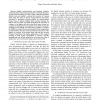Free Online Productivity Tools
i2Speak
i2Symbol
i2OCR
iTex2Img
iWeb2Print
iWeb2Shot
i2Type
iPdf2Split
iPdf2Merge
i2Bopomofo
i2Arabic
i2Style
i2Image
i2PDF
iLatex2Rtf
Sci2ools
IROS
2009
IEEE
2009
IEEE
A design and analysis tool for underactuated compliant hands
— Highly underactuated and passively adaptive robotic hands have shown great promise for robust performance in unstructured settings. In order to fully realize this potential, efficient tools are needed to analyze the execution of a grasp when using this class of devices. Along this line, this paper introduces a quasistatic analysis method for underactuated hands. First, we predict whether initial contacts between the fingers and the object are stable throughout the execution of a grasp, or the fingers will slip as the hand closes. Second, we compute the unbalanced forces applied to the object during the grasping process. Finally, once the grasp is complete, we analyze its stability as actuator forces are increased. These computations are performed in 3D, allow arbitrary kinematic structure of the fingers or geometry of the target object and take into account frictional constraints. We discuss applications of this method focusing on both on-line computation to execute a specific...
Adaptive Robotic Hands | IROS 2009 | Quasistatic Analysis Method | Robotics | Specific Grasping Task |
| Added | 24 May 2010 |
| Updated | 24 May 2010 |
| Type | Conference |
| Year | 2009 |
| Where | IROS |
| Authors | Matei T. Ciocarlie, Peter K. Allen |
Comments (0)

